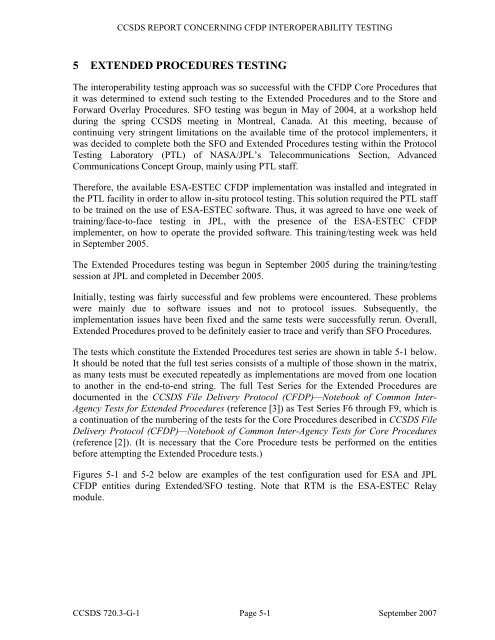CCSDS File Delivery Protocol (CFDP)âPart 3: Interoperability ...
CCSDS File Delivery Protocol (CFDP)âPart 3: Interoperability ...
CCSDS File Delivery Protocol (CFDP)âPart 3: Interoperability ...
You also want an ePaper? Increase the reach of your titles
YUMPU automatically turns print PDFs into web optimized ePapers that Google loves.
<strong>CCSDS</strong> REPORT CONCERNING <strong>CFDP</strong> INTEROPERABILITY TESTING<br />
5 EXTENDED PROCEDURES TESTING<br />
The interoperability testing approach was so successful with the <strong>CFDP</strong> Core Procedures that<br />
it was determined to extend such testing to the Extended Procedures and to the Store and<br />
Forward Overlay Procedures. SFO testing was begun in May of 2004, at a workshop held<br />
during the spring <strong>CCSDS</strong> meeting in Montreal, Canada. At this meeting, because of<br />
continuing very stringent limitations on the available time of the protocol implementers, it<br />
was decided to complete both the SFO and Extended Procedures testing within the <strong>Protocol</strong><br />
Testing Laboratory (PTL) of NASA/JPL’s Telecommunications Section, Advanced<br />
Communications Concept Group, mainly using PTL staff.<br />
Therefore, the available ESA-ESTEC <strong>CFDP</strong> implementation was installed and integrated in<br />
the PTL facility in order to allow in-situ protocol testing. This solution required the PTL staff<br />
to be trained on the use of ESA-ESTEC software. Thus, it was agreed to have one week of<br />
training/face-to-face testing in JPL, with the presence of the ESA-ESTEC <strong>CFDP</strong><br />
implementer, on how to operate the provided software. This training/testing week was held<br />
in September 2005.<br />
The Extended Procedures testing was begun in September 2005 during the training/testing<br />
session at JPL and completed in December 2005.<br />
Initially, testing was fairly successful and few problems were encountered. These problems<br />
were mainly due to software issues and not to protocol issues. Subsequently, the<br />
implementation issues have been fixed and the same tests were successfully rerun. Overall,<br />
Extended Procedures proved to be definitely easier to trace and verify than SFO Procedures.<br />
The tests which constitute the Extended Procedures test series are shown in table 5-1 below.<br />
It should be noted that the full test series consists of a multiple of those shown in the matrix,<br />
as many tests must be executed repeatedly as implementations are moved from one location<br />
to another in the end-to-end string. The full Test Series for the Extended Procedures are<br />
documented in the <strong>CCSDS</strong> <strong>File</strong> <strong>Delivery</strong> <strong>Protocol</strong> (<strong>CFDP</strong>)—Notebook of Common Inter-<br />
Agency Tests for Extended Procedures (reference [3]) as Test Series F6 through F9, which is<br />
a continuation of the numbering of the tests for the Core Procedures described in <strong>CCSDS</strong> <strong>File</strong><br />
<strong>Delivery</strong> <strong>Protocol</strong> (<strong>CFDP</strong>)—Notebook of Common Inter-Agency Tests for Core Procedures<br />
(reference [2]). (It is necessary that the Core Procedure tests be performed on the entities<br />
before attempting the Extended Procedure tests.)<br />
Figures 5-1 and 5-2 below are examples of the test configuration used for ESA and JPL<br />
<strong>CFDP</strong> entities during Extended/SFO testing. Note that RTM is the ESA-ESTEC Relay<br />
module.<br />
<strong>CCSDS</strong> 720.3-G-1 Page 5-1 September 2007

















